Mastering the Art of Outdoor Compost Storage: Essential Tips and Techniques
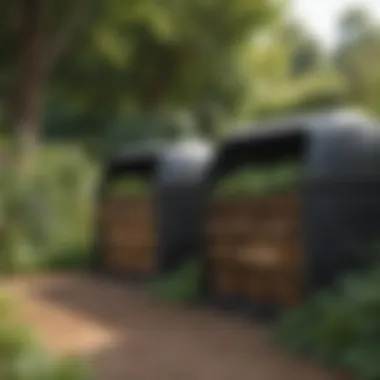
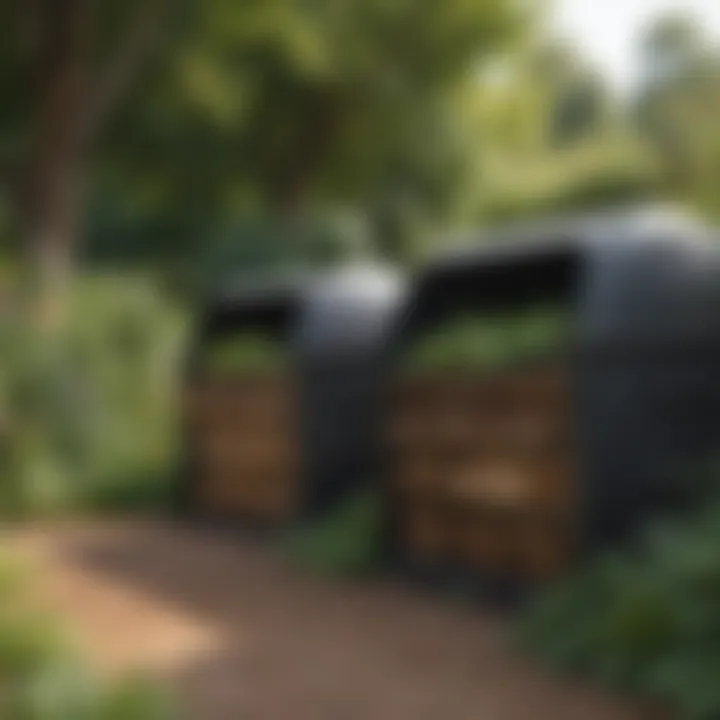
Overview of the Topic
Current Challenges and Best Practices
When storing compost outdoors, various challenges may arise, including odor issues, pest attraction, and improper decomposition. To address these challenges, using the right containers and following proper maintenance routines are essential. Achieving the correct balance of green and brown materials, adequate aeration, and moisture levels is key to successful composting.
Suitable Containers
Selecting the appropriate compost container is crucial for outdoor compost storage. Options include compost bins, tumblers, open piles, or vermicomposting systems. Each container type has its advantages depending on space, scale, and desired composting speed. Consider factors such as accessibility, aeration, and insulation when choosing a container for your composting needs.
Placement Considerations
Correct placement of the compost bin is essential for efficient composting. Choose a well-drained area with easy access for adding materials and turning the pile. Ensure the location receives adequate sunlight and airflow, promoting decomposition and discouraging moisture buildup. Avoid placing the compost pile too close to buildings or trees to prevent potential issues like root intrusion or structural damage.
Maintenance Routines
Regular maintenance is key to successful outdoor compost storage. Turning the pile every few weeks promotes aeration and accelerates decomposition. Monitoring moisture levels and adjusting as needed helps prevent odor problems and ensures optimal composting conditions. Additionally, checking the temperature of the compost pile can indicate the effectiveness of decomposition and the need for adjustments in the carbon-to-nitrogen ratio.
Troubleshooting Common Issues
Despite best practices, challenges like foul odors, pests, or slow decomposition may occur during outdoor compost storage. To address these issues, consider adjusting the C:N ratio, incorporating additional brown materials, or covering the compost pile to deter pests. Implementing proper troubleshooting techniques is vital for maintaining a healthy compost pile and achieving successful composting outcomes.
Impact and Significance
Properly storing compost outside not only contributes to reducing waste and improving soil quality but also plays a crucial role in promoting sustainable practices for future generations. By composting organic materials, individuals can minimize their environmental footprint, support plant growth, and contribute to the preservation of natural resources. Embracing outdoor compost storage is a significant step towards fostering eco-friendly habits and nurturing a more sustainable world.
Introduction
In the realm of sustainable practices, the topic of storing compost outdoors holds a pivotal role. Composting, a natural process that converts organic waste into nutrient-rich soil amendment, plays a crucial part in reducing waste and promoting environmental health. Exploring the nuances of storing compost outdoors unveils a realm of benefits and considerations that can significantly impact the efficiency and effectiveness of composting efforts.
Compost storage outdoors not only facilitates the natural decomposition process but also fosters the enrichment of soil health. By allowing organic material to break down naturally, composting contributes to the regeneration of nutrient-dense soil, essential for sustainable gardening and farming practices. Furthermore, opting for outdoor compost storage aids in diminishing landfill waste, thereby reducing the strain on waste management systems and promoting a more eco-conscious approach to handling organic refuse.
Delving into the intricacies of outdoor compost storage entails a meticulous approach towards selecting appropriate containers, finding the ideal placement, implementing proper maintenance routines, and addressing potential troubleshooting issues. This comprehensive guide aims to equip conservationists, students, and environmentalists with the necessary knowledge and strategies to master the art of composting sustainably, fostering a greener and healthier planet for future generations.
Benefits of Outdoor Compost Storage
When exploring the realm of composting, opting to store compost outdoors presents a multitude of advantages. This section delves deep into the pivotal reasons why outdoor compost storage is not only beneficial but also crucial for individuals looking to engage in sustainable practices. Let's dissect each aspect to unveil the essence of outdoor compost storage.
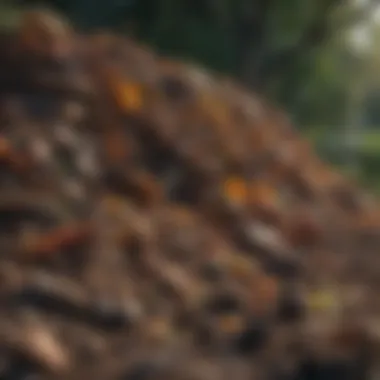
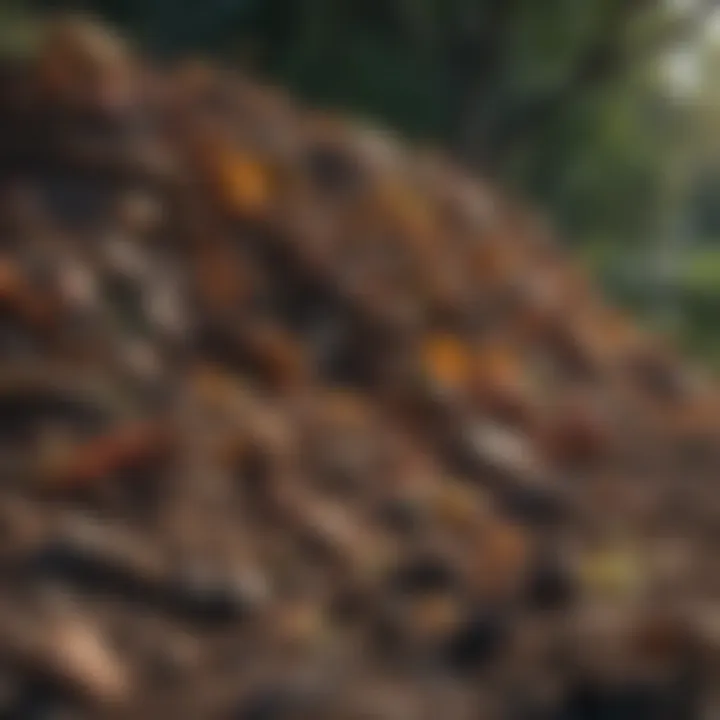
Promotes Natural Decomposition Process
Delving into the intricacies of outdoor compost storage leads us to the fundamental concept of promoting the natural decomposition process. By allowing organic materials to break down naturally under outdoor conditions, it fosters an environment where microorganisms, bacteria, and fungi can thrive harmoniously. Through this process, organic matter transforms into nutrient-rich humus, which serves as a robust foundation for enriching soil quality and promoting plant growth. This symbiotic relationship between natural elements highlights the essence of embracing outdoor compost storage as a catalytic agent for sustainable environmental practices.
Enhances Soil Health
The saga of outdoor compost storage unfolds a crucial chapter in enhancing soil health. As compost decomposes in an outdoor setting, it infuses the soil with a plethora of essential nutrients, such as nitrogen and phosphorus, fostering a fertile ground for cultivation. This nutrient-rich blend not only aids in improving soil structure but also enhances water retention capacity, ultimately leading to healthier and more vibrant plant growth. Embracing outdoor compost storage as a mechanism to bolster soil health epitomizes a synergy between natural processes and sustainable living practices.
Reduces Landfill Waste
In the realm of waste management, outdoor compost storage emerges as a beacon of hope for reducing landfill waste. By diverting organic materials from conventional waste streams and harnessing their potential through composting, individuals can significantly minimize the volume of waste destined for landfills. This not only alleviates the burden on landfill sites but also diminishes greenhouse gas emissions generated by organic matter undergoing anaerobic decomposition in landfills. Seamlessly integrating outdoor compost storage into daily routines embodies a conscious effort towards waste reduction and environmental preservation, echoing the principles of circular economy and sustainable resource management.
Choosing the Right Compost Container
When delving into the realm of outdoor compost storage, selecting the right compost container is a pivotal decision that can significantly impact the composting process. The container serves as the ecosystem where organic waste undergoes decomposition, necessitating careful consideration of various elements to ensure optimal composting results. By choosing the appropriate container, one can facilitate efficient decomposition and maintain a suitable environment for beneficial microorganisms to thrive.
Types of Containers to Consider
Compost Bin
Exploring the realm of composting containers, the compost bin emerges as a versatile and practical choice for compost enthusiasts. Characterized by its sturdy construction and ample capacity, the compost bin provides a controlled environment for composting materials to break down gradually. Its enclosed design helps regulate temperature and moisture levels, fostering the ideal conditions for microbial activity essential for successful decomposition. While the compost bin may require initial investment, its long-term benefits in terms of efficient composting make it a popular selection among gardening aficionados.
DIY Pallet Composter
In the realm of sustainable composting solutions, the DIY pallet composter stands out as an innovative and eco-friendly option. Crafted from repurposed wooden pallets, this composter offers a cost-effective means of creating a composting system tailored to individual needs. Its customizable design allows for easy assembly and modification, adapting to varying composting requirements. Despite its DIY nature, the pallet composter's simplicity and functionality make it a favored choice for environmentally-conscious individuals seeking a hands-on approach to composting.
Tumbler Composter
For those desiring convenience and efficiency in composting, the tumbler composter presents an attractive solution. Characterized by its rotating drum design, the tumbler composter simplifies the composting process by enabling easy aeration and mixing of compost materials. This frequent agitation promotes aerobic decomposition, accelerating the breakdown of organic matter into nutrient-rich compost. While the tumbler composter may have a smaller capacity compared to other containers, its ease of use and ability to expedite composting make it a popular option for individuals seeking a streamlined composting experience.
Factors to Evaluate
Capacity
When selecting a compost container, considering its capacity is essential to accommodate the volume of organic waste generated. Opting for a container with sufficient capacity ensures that there is ample space for materials to decompose effectively without overcrowding. Balancing the container's size with the amount of compostable waste produced helps maintain a harmonious composting process, preventing issues related to overcrowding or insufficient aeration.
Material Durability
The durability of the compost container's material plays a crucial role in its longevity and resilience to outdoor elements. Choosing a durable material such as UV-resistant plastic or galvanized steel enhances the container's ability to withstand weather conditions and external impacts. Additionally, durable materials contribute to prolonging the lifespan of the compost container, ensuring an enduring investment in sustainable composting practices.
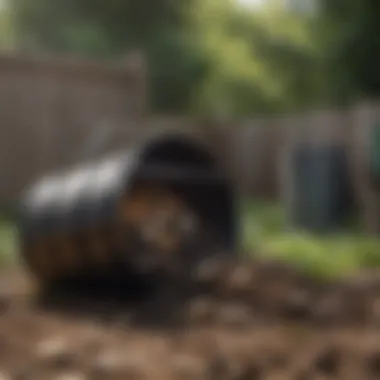
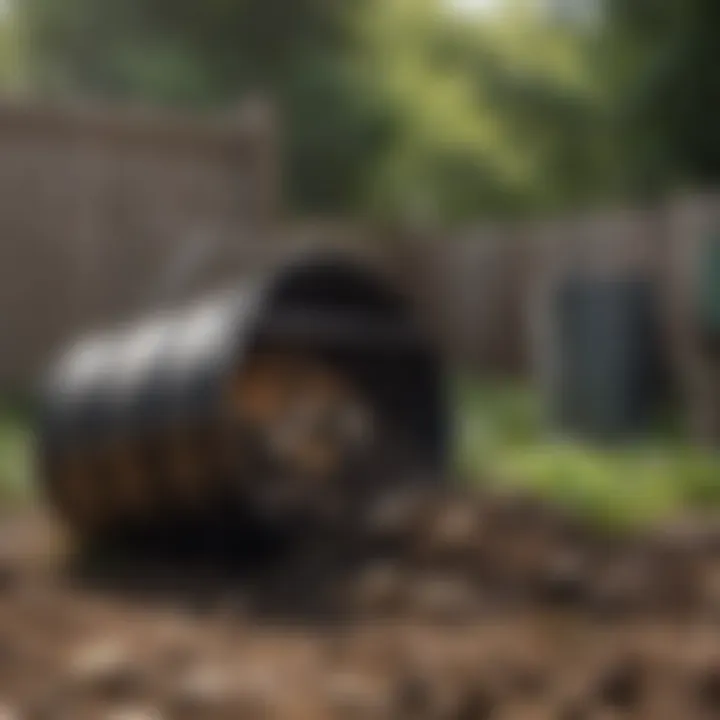
Aeration
Aeration is a fundamental aspect of successful composting, influencing microbial activity and decomposition rates within the compost pile. Containers that facilitate adequate aeration through ventilation systems or perforated designs promote the circulation of oxygen-rich air essential for microbial growth. Proper aeration prevents anaerobic conditions that may cause foul odors or inhibit decomposition, fostering a healthy and active composting environment.
Ideal Placement for Compost Containers
In the realm of outdoor composting, determining the ideal placement for compost containers holds paramount importance. The strategic positioning of these containers contributes significantly to the successful decomposition process, ultimately impacting the quality of the compost produced and the overall sustainability of the practice. By selecting the optimal location for your compost containers, you are setting the stage for efficient waste transformation and nutrient-rich soil creation.
When considering the ideal placement for compost containers, several key elements come into play. Firstly, the proximity to a water source is crucial to ensure easy access for maintaining appropriate moisture levels within the compost. Additionally, placing the containers in a spot with adequate sunlight exposure and proper ventilation facilitates the decomposition process by promoting the activity of beneficial microorganisms. Moreover, choosing a level surface can aid in proper drainage, preventing waterlogging that could impede decomposition.
Furthermore, the benefits of thoughtfully selecting the placement for compost containers extend beyond just the composting process itself. Placing the containers in a convenient location can encourage regular maintenance and monitoring, fostering a sustainable composting routine. It also ensures that the compost pile remains undisturbed, minimizing the chances of unwanted disruptions or contamination.
Overall, understanding the significance of ideal placement for compost containers is the cornerstone of successful outdoor composting. By factoring in elements such as water access, sunlight exposure, and maintenance convenience, you can maximize the efficacy of your composting efforts and yield nutrient-rich compost for your gardening endeavors.
Sunlight Exposure Considerations
When deliberating on outdoor compost storage, one crucial aspect to contemplate is the sunlight exposure that the compost containers will receive. Sunlight plays a pivotal role in the composting process as it helps regulate the internal temperature of the compost pile, facilitating the breakdown of organic materials.
Optimal sunlight exposure for compost containers typically involves placing them in a location that receives moderate sun exposure throughout the day. Excessive exposure to direct sunlight can lead to overheating of the compost, potentially killing off beneficial organisms essential for decomposition. Conversely, inadequate sunlight exposure may result in slower decomposition rates and the accumulation of unprocessed materials.
Balancing sunlight exposure is key to maintaining an efficient composting environment. By strategically placing the containers in an area that receives partial sunlight or dappled shade, you can create an ideal setting for microbial activity and decomposition. This approach ensures that the compost reaches the desired temperature for effective breakdown while preserving the vitality of the compost ecosystem.
In essence, understanding how sunlight exposure influences composting processes is integral to optimizing outdoor compost storage. By fine-tuning the placement of your containers to achieve the right balance of sunlight exposure, you can cultivate a thriving compost ecosystem and produce high-quality compost for sustainable gardening practices.
Drainage Requirements
A fundamental consideration in outdoor compost storage revolves around the drainage requirements of compost containers. Proper drainage is essential to prevent waterlogged conditions that can impede the decomposition process and lead to unpleasant odors or the formation of anaerobic zones within the compost pile.
Maintaining adequate drainage involves placing the compost containers on a slightly elevated surface or incorporating drainage holes at the base of the containers to facilitate water flow. This design feature allows excess moisture to drain away from the compost pile, preventing saturation and promoting aeration throughout the materials. Furthermore, ensuring that the surrounding area is free from obstructions that could obstruct drainage channels is crucial in preventing water buildup and ensuring optimal composting conditions.
By adhering to effective drainage practices, you can safeguard the integrity of the compost pile and create a conducive environment for beneficial microbial activity. Proper drainage not only aids in controlling moisture levels but also helps mitigate the risk of pest infestations or foul odors associated with water accumulation in the compost.
Accessibility for Maintenance
The accessibility of compost containers for maintenance purposes is a critical factor that greatly influences the overall efficiency and success of outdoor compost storage. Easy access to the compost pile facilitates regular turning, mixing, and monitoring, ensuring that the compost remains aerated, well-blended, and adequately managed to promote efficient decomposition.
When considering the accessibility of compost containers, factors such as proximity to pathways, gardening tools, and water sources should be taken into account. Placing the containers within convenient reach allows for seamless maintenance activities without the need for extensive effort or time-consuming maneuvers. Additionally, ensuring that the containers are positioned in an area free from obstacles or physical barriers further enhances accessibility and simplifies the maintenance process.
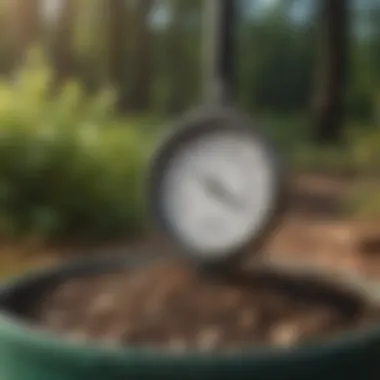

Accessible compost containers also encourage regular observation of the compost pile, enabling timely adjustments to moisture levels, ingredient ratios, or aeration methods as needed. This proactive approach to maintenance promotes consistent compost quality and accelerates the decomposition timeline, leading to the production of nutrient-rich compost for gardening applications.
In summary, prioritizing accessibility for maintenance in outdoor compost storage optimizes the functionality of compost containers and streamlines the composting process. By strategically siting the containers for easy access and incorporating practical design elements, you can cultivate a sustainable composting routine that yields beneficial outcomes for both your garden and the environment.
Maintaining Outdoor Compost
In the realm of sustainable practices, maintaining outdoor compost plays a pivotal role in fostering a thriving ecosystem in your compost containers. The significance of this topic within the broader context of compost storage lies in its influence on compost quality, nutrient availability, and the overall success of the composting process. Turning the compost regularly ensures that all parts of the mixture are equally exposed to oxygen, aiding in the decomposition process. Mixing compost helps in balancing the carbon and nitrogen ratio, essential for the breakdown of organic matter. Adequate aeration and mixing prevent the compost from becoming compacted, promoting microbial activity and accelerating decomposition.
Turning and Mixing Compost (
Turning and mixing compost is not merely a physical task but a scientific endeavor with ecological implications. By aerating the compost pile, you enhance oxygen flow, thereby facilitating the growth of aerobic bacteria essential for decomposition. This aerobic process results in the breakdown of organic materials into nutrient-rich humus, a vital component for enriching soil fertility. The act of turning and mixing compost also helps in eliminating potential anaerobic zones inside the pile, thus reducing the risk of unpleasant odors and harmful microbial activity.
)
Managing Moisture Levels
Managing moisture levels in your outdoor compost setup is crucial for ensuring optimal decomposition efficiency. Compost organisms, including bacteria and fungi, require a moist environment to proliferate and break down organic matter effectively. Monitoring moisture content prevents the compost from becoming too dry, which slows down the decomposition process, or too wet, leading to anaerobic conditions and unpleasant odors. By maintaining the appropriate moisture level, usually akin to a squeezed-out sponge, you create a hospitable environment for beneficial microorganisms to thrive and transform waste into nutrient-rich compost adapted for your garden's needs.
Balancing Green and Brown Materials
Achieving the right balance between green (nitrogen-rich) and brown (carbon-rich) materials in your outdoor compost heap is key to successful composting. Green materials such as vegetable scraps, grass clippings, and coffee grounds provide nitrogen, while brown materials like dry leaves, straw, and shredded paper offer carbon. Balancing these components ensures an optimal carbon-to-nitrogen ratio, facilitating microbial activity and maintaining an odor-free compost pile. Regularly layering green and brown materials while composting promotes a harmonious environment where microorganisms synergistically decompose organic matter, resulting in nutrient-dense compost fit for enhancing soil health and fostering sustainable gardening practices.
Troubleshooting Compost Issues
In the realm of outdoor compost storage, troubleshooting compost issues occupies a crucial position. Understanding how to identify and address common problems that may arise during the composting process is essential to maintaining a successful and sustainable composting system. Proper troubleshooting ensures that the compost remains healthy, efficient, and odor-free, contributing to a smoother composting journey overall.
Foul Odors
Foul odors emanating from compost can be a significant concern for composters. These unpleasant smells not only indicate potential issues within the compost pile but can also attract unwanted pests and detract from the overall composting experience. The presence of foul odors is often linked to inadequate aeration, excessive moisture levels, or an imbalance of green and brown materials. By addressing these factors through proper aeration, adjusting moisture levels, and ensuring a balanced mix of materials, composters can effectively mitigate foul odors and promote a healthier composting environment.
Pest Infestations
Dealing with pest infestations in outdoor compost can present a challenge for compost enthusiasts. Pests such as flies, rodents, and other unwanted visitors may be drawn to the compost pile, causing disturbances and potentially spreading diseases. Preventing pest infestations involves proper management of the compost pile, including regularly turning and mixing the compost to deter pests, securing compost containers to limit access, and avoiding the inclusion of certain food scraps that may attract pests. By implementing these strategies, composters can minimize the risk of pest infestations and maintain a hygienic composting space.
Slow Decomposition
Slow decomposition rates can hinder the composting process, leading to delays in the transformation of organic material into nutrient-rich compost. Several factors can contribute to slow decomposition, such as insufficient aeration, improper moisture levels, or an imbalance of carbon and nitrogen ratios. To address this issue, composters can optimize aeration by turning and mixing the compost regularly, adjust moisture levels to promote microbial activity, and ensure a balanced mix of green and brown materials for optimal decomposition. By fine-tuning these aspects, composters can accelerate the composting process and achieve a steady production of high-quality compost.
Conclusion
In the intricate realm of composting, the conclusion serves as the pivotal point where the essence of outdoor compost storage converges. As the curtains draw near on this informational journey, it becomes evident that the significance of this conclusive segment transcends mere termination; it encapsulates the essence of sustainable practices and environmental stewardship. The embodiment of the conclusion lies in its ability to consolidate the nuances of choosing the right compost container, ideal placement considerations, paramount maintenence routines, and troubleshooting methods.
Delving deeper, the conclusion symbolizes a call to action for conservationists, students, and environmentalists alike to embrace outdoor compost storage as a beacon of eco-consciousness. The layers of this article unravel to reveal the intricacies of composting, broaching topics from natural decomposition processes to reducing landfill waste. As the narrative culminates in the conclusion, it solidifies the reader's comprehension of the holistic approach required in maintaining compost quality and fostering sustainable living.
Moreover, the conclusion acts as a compass guiding individuals towards becoming mindful stewards of the environment. It underlines the imperative role of every conscientious citizen in embracing composting as a catalyst for positive change. The insights shared throughout this article poignantly emphasize that outdoor compost storage is not merely a task; rather, it is a transformative practice that aligns with the ethos of environmental conservation and sustainable living. In essence, the conclusion encapsulates a harmonious blend of informative discourse and pragmatic advice aimed at nurturing a greener, healthier planet for current and future generations.



